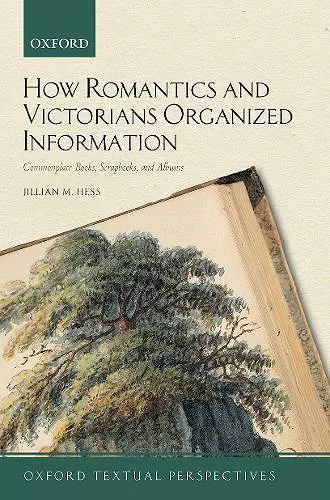How Romantics and Victorians Organized Information
Commonplace Books, Scrapbooks, and Albums
Format:Paperback
Publisher:Oxford University Press
Published:4th Aug '22
Should be back in stock very soon
This paperback is available in another edition too:
- Hardback£87.00(9780192895318)

Every literary household in nineteenth-century Britain had a commonplace book, scrapbook, or album. Coleridge called his collection "Fly-Catchers", while George Eliot referred to one of her commonplace books as a "Quarry," and Michael Faraday kept quotations in his "Philosophical Miscellany." Nevertheless, the nineteenth-century commonplace book, along with associated traditions like the scrapbook and album, remain under-studied. This book tells the story of how technological and social changes altered methods for gathering, storing, and organizing information in nineteenth-century Britain. As the commonplace book moved out of the schoolroom and into the home, it took on elements of the friendship album. At the same time, the explosion of print allowed readers to cheaply cut-and-paste extractions rather than copying out quotations by hand. Built on the evidence of over 300 manuscripts, this volume unearths the composition practices of well-known writers such as Samuel Taylor Coleridge, Sir Walter Scott, George Eliot, and Alfred Lord Tennyson, and their less well-known contemporaries. Divided into two sections, the first half of the book contends that methods for organizing knowledge developed in line with the period's dominant epistemic frameworks, while the second half argues that commonplace books helped Romantics and Victorians organize people. Chapters focus on prominent organizational methods in nineteenth-century commonplacing, often attached to an associated epistemic virtue: diaristic forms and the imagination (Chapter Two); "real time" entries signalling objectivity (Chapter Three); antiquarian remnants, serving as empirical evidence for historical arguments (Chapter Four); communally produced commonplace books that attest to socially constructed knowledge (Chapter Five); and blank spaces in commonplace books of mourning (Chapter Six). Richly illustrated, this book brings an archive of commonplace books, scrapbooks, and albums to the reader.
Readers interested in book history, media archeology, the material cultures of reading, and the evolution of the commonplace tradition over the course of the nineteenth century will return to this book over and over again. * Ann Wierda Rowland, The Coleridge Bulletin: The Journal of the Friends of Coleridge. *
Hess gets at fundamental issues of the bibliographic imagination in the nineteenth century, with particular relevance to our own scholarly methods. Her book will be a crucial point of reference for scholars working on the dialectic of the commons and the individual, or the objective and the subjective, in this period. It also opens a historical window on the textual regimes of collecting, organizing, and sharing excerpts in our time of digital cut-and-paste and social media. By attending to the commonplace, Hess has produced a singular and uniquely valuable work of literary history. * Andrew Stauffer, Victorian Studies *
- Winner of Honourable mention, British Association of Romanticism first book prize.
ISBN: 9780192896070
Dimensions: 204mm x 137mm x 17mm
Weight: 416g
336 pages